“At Home in Canada”: Royalty at Canada’s Historic Places
|
"And as in all our visits down the years, whether watching a
chuck wagon race at the Calgary Stampede or athletic prowess at the
Montréal Olympics, whether listening to an Inuit song of greeting
in Nunavut or the skirl of the pipes in Nova Scotia, I have always
felt not only welcome but at home in Canada."
Queen Elizabeth II
Edmonton, Alberta May 2005
|
Canada's ties to the British monarchy run deep. While some
remain unsympathetic to authority and tradition, it is undeniable
that the majority of Canadians have an obsession or, at least, a
curiosity with the royals. This sentiment was demonstrated
during the 2011 Royal Tour of Canada featuring their Royal
Highnesses the Duke and Duchess of Cambridge who were greeted by
throngs of onlookers and admirers eager to catch a glimpse of or
meet William and Catherine. The tour did more than bolster
the celebrity status of the royal couple; it helped reinforce our
country's collective heritage. James Moore, Minister of
Canadian Heritage, expressed that the tour "provides Canadians with
the opportunity to highlight their history, traditions, and shared
values, while also strengthening our Canadian identity."
Canada's historic places provide the perfect setting for these
bonds to nationalism to be forged and strengthened.
Canada's heritage is unquestionably linked with the history of
monarchy for it is under the patronage of European rulers that
Canada was explored, exploited, then later settled and fought
over. Canada's association with the British monarchy expanded
following the 1763 Treaty of Paris which saw France cede much of
North America to Great Britain. Since then, our ties to the
Crown have become a part of daily life: look no further than the
coins in your wallet! Other reminders of this imperial link
include: Victoria Day, the Royal Canadian Mounted Police, Lake
Louise and Alberta (named after Princess Louise Caroline Alberta,
1848-1939), Ontario's Queen Elizabeth Way (QEW Highway), and the
list goes on...
The first member of the British royal family to set foot on
Canadian soil was Prince William (later King William IV). Son
of King George III and Royal Navy officer, he arrived in
Newfoundland and Nova Scotia in 1786. While in Placentia,
Newfoundland, he commissioned a church, St Luke's, elements of
which have been incorporated into the newer St. Luke's Anglican Church Municipal Heritage
Building. Since then, numerous royals have visited Canada
during their military careers including Queen Elizabeth II's
grandson, Prince Harry, who trained at CFB Suffield, Alberta in 2007, while others
have toured the country during official and private visits.
the newer St. Luke's Anglican Church Municipal Heritage
Building. Since then, numerous royals have visited Canada
during their military careers including Queen Elizabeth II's
grandson, Prince Harry, who trained at CFB Suffield, Alberta in 2007, while others
have toured the country during official and private visits.
Historically, many of Canada's designated historic places have
provided the ideal setting for people to demonstrate their pride in
being associated with the British Empire. With a new
parliament building in the works for Ottawa in 1859, Canadian
Parliament invited Queen Victoria to Canada. In her place,
she sent her 18 year-old son Prince Edward (later King Edward VII)
on a tour of the provinces in 1860 including a visit to Province House in Charlottetown, Prince Edward
Island. This first official royal tour of British North
America was considered a success and helped lead to the unification
of the provinces by confirming a common bond between colonists:
allegiance to the Queen (Bousfield & Toffoli, 56). Not
long after the Prince's visit, this grand Neoclassical structure, a
source of pride for islanders, would become a symbol of the
birthplace of our country after hosting the Charlottetown
Conference of 1864 which eventually lead to Canadian Confederation
in 1867.
 Canada's built heritage
also provided an excellent backdrop for confirming loyalty to the
Crown. During Prince Edward's 1860 visit, a July
24th article in the Ottawa newspaper Citizen
described the spectacle of a royal tour: "Canada is preparing -
like a bride putting on her robes, - to meet her future sovereign
and invited guest." Similar pageantry, including flags,
banners and bunting, was on display at Calgary's City Hall during the 1912 tour of Prince
Arthur, Duke of Connaught, Governor General of Canada from 1911 to
1916. Completed just the year before the tour, the imposing
City Hall was not only a symbol of ambition, progress and
prosperity for Calgary but also became a place for reaffirming the
loyalty of the nation to their king.
Canada's built heritage
also provided an excellent backdrop for confirming loyalty to the
Crown. During Prince Edward's 1860 visit, a July
24th article in the Ottawa newspaper Citizen
described the spectacle of a royal tour: "Canada is preparing -
like a bride putting on her robes, - to meet her future sovereign
and invited guest." Similar pageantry, including flags,
banners and bunting, was on display at Calgary's City Hall during the 1912 tour of Prince
Arthur, Duke of Connaught, Governor General of Canada from 1911 to
1916. Completed just the year before the tour, the imposing
City Hall was not only a symbol of ambition, progress and
prosperity for Calgary but also became a place for reaffirming the
loyalty of the nation to their king.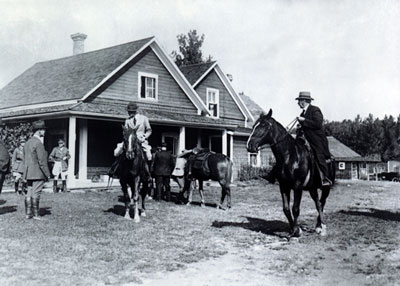
Following the First World War, King George V sent his son the
Prince of Wales (later King Edward VIII) on a number of royal tours
to strengthen the unity of Great Britain with her empire.
Over the next several years, the Prince visited Canada (1919),
Australia and New Zealand (1920), India (1921), and Africa
(1925). While in Canada, he participated in a number of
distinctly "Canadian" activities including being entertained by the
equestrian abilities of the RCMP and bronco busting in
Saskatchewan, being elected a tribal chief and given the title
'Morning Star' by a group of First Nations in Banff, Alberta, and
fishing on Lake Nipigon in Ontario. "I want Canada to look
upon me as a Canadian," he stated, "if not actually by birth, yet
certainly in mind and spirit." (Fabb, 105). 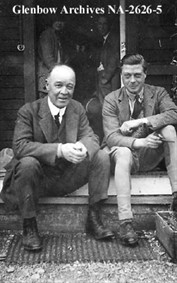
He was, however, taken the most by life in the West. In
southern Alberta's foothills, the Prince was welcomed to Bar U Ranch by George Lane, co-founder of the
Calgary Stampede. This place, a significant example of
Canada's ranching industry which speaks to the well-established
ranching tradition typical in western Canada, motivated the Prince
to purchase his own ranch nearby. "The free, vigorous,
hopeful spirit of westerners not only inspires me," he declared,
"but makes me feel happy and at home." Renamed E.P. Ranch (E.P. signifying Edward Prince), the
Prince enjoyed a private visit to his rural homestead on Canadian
soil in 1923 where he participated in all the typical ranch chores
including chopping wood, mucking the cowhouse, and filling the
silo. In between work, he and the other hired hands dined on
the fruits of their labour: flapjacks, corn on the cob, carrots and
beets (Bousfield & Toffoli, 95-8). While not a Canadian
by birth, it was at his ranch that the Prince was able to
nevertheless feel like a young Canadian by experiencing traditions
and practices typical of pioneering life out West.

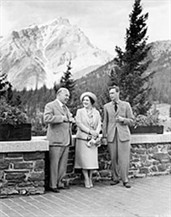 One of the grandest and
most ambitious royal tours of the 20th century was King
George VI and Queen Elizabeth's visit in 1939, the first tour of
Canada by reigning monarchs in our history. They made stops
across the country, visiting every province. As with earlier
royal tours, this one also helped unify the nation by providing a
shared identity and history. National landmarks on the tour
included Ottawa's Château Laurier where all the pomp and ceremony
of a royal banquet were on display, as well as Banff Springs Hotel in Banff, Alberta.
These hotels, built by Canadian railway companies to encourage
tourist to ride the train remain endearing emblems of Canada.
One of the grandest and
most ambitious royal tours of the 20th century was King
George VI and Queen Elizabeth's visit in 1939, the first tour of
Canada by reigning monarchs in our history. They made stops
across the country, visiting every province. As with earlier
royal tours, this one also helped unify the nation by providing a
shared identity and history. National landmarks on the tour
included Ottawa's Château Laurier where all the pomp and ceremony
of a royal banquet were on display, as well as Banff Springs Hotel in Banff, Alberta.
These hotels, built by Canadian railway companies to encourage
tourist to ride the train remain endearing emblems of Canada. 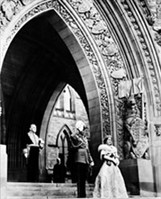
While in Ottawa, King George gave royal assent to bills in the
Senate before posing for a photo under the iconic Peace Tower of
the Parliament Building, a powerful symbol of
Canadian governance and democracy. During the laying of
the corner stone for the Supreme Court Building, the Queen gave her
first speech in Canada pronouncing: "Perhaps it is not
inappropriate that this task should be performed by a woman; for
woman's position in a civilized society has depended upon the
growth of law" (Fleming, 53). This building is now a dominant
symbol of Canada's justice system and represents the rights and
freedoms we all share. 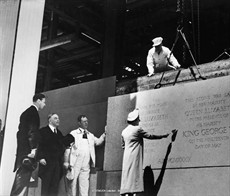
Since 1939, members of the royal family continue to visit
Canada, but none have spent more time on official tours in this
country than Queen Elizabeth II, Canada's reigning monarch since
she ascended the throne in 1952. The Globe and Mail
affirmed that Queen Elizabeth II was "The living symbol of our
heritage, both English and French" (Bousfield & Toffoli, 156)
and she has shared with us many milestones in our nation's history
such as the 1959 opening of the St. Lawrence Seaway, the centennial
of Confederation in 1967, and the 1976 Summer Olympic Games held in
Montréal. During the latter tour, their Royal Highnesses
visited Kings Landing Historical Settlement in Prince
William, New Brunswick a living history museum of heritage
buildings relocated during a 1960s hydroelectric project
representing the evolution of rural life in the province from the
1790s to early 1920s.
 The presence of the
monarchy at our historic places and during these defining moments
of our past underscores the national significance of these places
and events for our collective heritage. In his speech at
Charlottetown in 2011, given 151 years after his ancestor Prince
Edward stood in the same place, Prince William expressed: "It is
quite a moment for Catherine and me to be standing here in the
Atlantic Canada, in front of Province House, where Canadian federation was
forged.... Here, in the crucible of Canadian nationhood, we look
forward to meeting many of you." These words echo the
importance of historic places as enduring symbols of our shared
history. Just like our connection to the Crown, our historic
places provide us with a sense of continuity in Canada's
ever-changing, global environment.
The presence of the
monarchy at our historic places and during these defining moments
of our past underscores the national significance of these places
and events for our collective heritage. In his speech at
Charlottetown in 2011, given 151 years after his ancestor Prince
Edward stood in the same place, Prince William expressed: "It is
quite a moment for Catherine and me to be standing here in the
Atlantic Canada, in front of Province House, where Canadian federation was
forged.... Here, in the crucible of Canadian nationhood, we look
forward to meeting many of you." These words echo the
importance of historic places as enduring symbols of our shared
history. Just like our connection to the Crown, our historic
places provide us with a sense of continuity in Canada's
ever-changing, global environment. 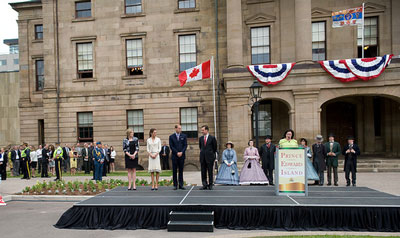
This is only a sample of historic places graced by royalty.
There are many more places across the country. Perhaps
you have been privileged with a royal sighting during a stop at one
of our many heritage railway stations, or entering a historic
hotel, or giving an address at a legislature, or visiting a
national historic site. If the past is any indication of the
future, the royals will be back to celebrate Canada!